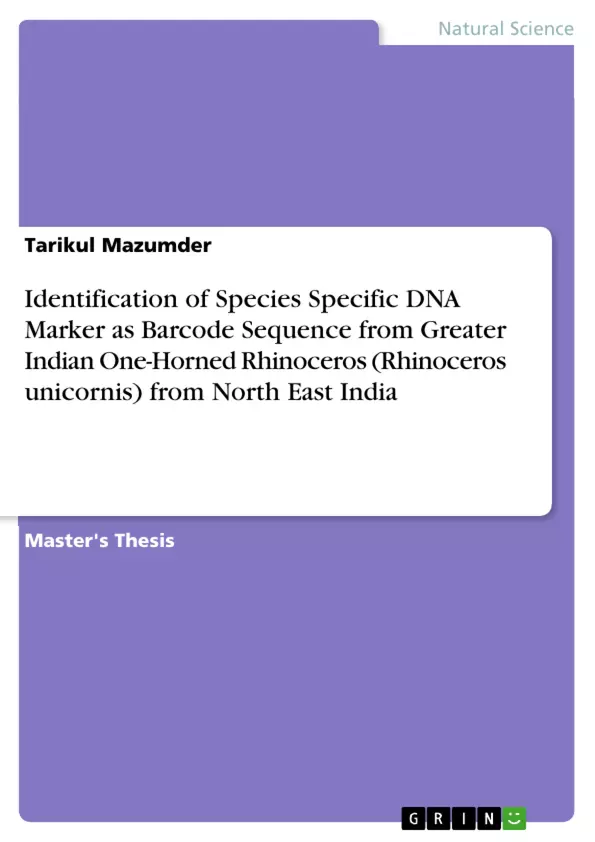The North East India is a reservoir of rich biodiversity for much of India’s flora and fauna, and as a consequence, the region is one of the richest in biological values. DNA based species identification or DNA barcoding is an exciting tool for documenting biodiversity with a gene sequence. Here we focused on the development of DNA barcode sequence of Greater Indian one-horned Rhinoceros [Rhinoceros unicornis] by determining the DNA sequence of its mitochondrial 5´ COI gene region using cross primer design for PCR amplification. The cross species primer pairs of forward primer fish [FISH COX F] and reverse primer invertebrate [INV R] DNA barcoding, successfully amplified the barcode sequence of R. unicornis which is confirmed through similarity search in National Centre for Biotechnology [NCBI, www.ncbi.nlm.nih.gov] and Barcode of life [BOLD] database and submitted to NCBI-GenBank with accession no. JN417004 is the first COI barcode sequence of R. unicornis of Greater Indian one-horned Rhino. We observed the maximum identification of the query sequence in case of R. unicornis (99%) and R. sondaicus (93%). Mean pair wise distance was computed using K2P to check the inter species divergence between all species in each genus among the members of Rhinoceretidae family in COI region taking 632 bp into consideration, within species was found to be 0.002 as the maximum and 0.000 as the minimum and that of in between species was found to be 0.064 as the maximum and 0.000 as the minimum. The study represents development of COI species specific DNA barcode of R. unicornis with regard to conservation and trade aspect. The cross species primer pair to amplify barcode gene for a species for which no specific primer are available represents a noble approach for barcoding on those areas like North East India where biological diversity is high.
Inhaltsverzeichnis (Table of Contents)
- CHAPTER-1 Introduction
- CHAPTER- 2 Review of literature
- CHAPTER- 3 Materials and methods
- CHAPTER -4 Results
- CHAPTER - 5 Discussion
- REFERENCES
Zielsetzung und Themenschwerpunkte (Objectives and Key Themes)
This project report aims to identify a species-specific DNA marker, serving as a barcode sequence, for the Greater Indian One-Horned Rhinoceros (Rhinoceros unicornis) found in Northeast India. The research investigates the use of DNA barcoding techniques for species identification and conservation efforts.
- Identification of a species-specific DNA marker
- Application of DNA barcoding for species identification
- Conservation implications of DNA barcoding techniques
- Genetic diversity of the Greater Indian One-Horned Rhinoceros
- Role of molecular techniques in wildlife conservation
Zusammenfassung der Kapitel (Chapter Summaries)
CHAPTER-1 Introduction: This chapter introduces the significance of DNA barcoding for species identification and conservation, focusing on the challenges faced by the Greater Indian One-Horned Rhinoceros. It discusses the importance of molecular tools in wildlife conservation and the potential of DNA barcoding for monitoring rhinoceros populations. CHAPTER- 2 Review of literature: This chapter presents a comprehensive review of existing literature on DNA barcoding, focusing on its applications in wildlife conservation and species identification. It explores various DNA barcode regions and their effectiveness in differentiating rhinoceros species. CHAPTER- 3 Materials and methods: This chapter outlines the materials and methodologies used in the project. It details the sampling procedures, DNA extraction techniques, PCR amplification, sequencing protocols, and data analysis methods employed. CHAPTER -4 Results: This chapter presents the findings of the study, including the identification of potential DNA barcode regions, their sequence variations, and the development of a species-specific DNA marker for the Greater Indian One-Horned Rhinoceros.
Schlüsselwörter (Keywords)
DNA barcoding, species identification, conservation, Greater Indian One-Horned Rhinoceros (Rhinoceros unicornis), genetic diversity, mitochondrial DNA, cytochrome oxidase subunit I (COI), PCR, sequencing, data analysis.
- Arbeit zitieren
- Research Scholar Tarikul Mazumder (Autor:in), 2014, Identification of Species Specific DNA Marker as Barcode Sequence from Greater Indian One-Horned Rhinoceros (Rhinoceros unicornis) from North East India, München, GRIN Verlag, https://www.grin.com/document/278349



